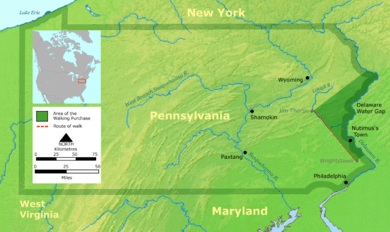Sassoonan facts for kids
Quick facts for kids
Sassoonan or Allumapees
|
|
|---|---|
| Born |
Sassoonan
1675 |
| Died | October 15, 1747 (aged 72) |
| Years active | 1715-1744 |
| Known for | Promoting peaceful coexistence with English colonists |
| Predecessor | Skalitchy (aka Gollitchy) |
| Successor | Shingas |
| Parent(s) | Tamanend (father) |
Sassoonan (born around 1675, died 1747) was an important leader of the Lenape people in Pennsylvania. He was also known as Allumapees. He was famous for talking with the Pennsylvania government about land deals. He was a respected leader, but his power lessened as some Lenape moved to the Ohio Country. He passed away in Shamokin in 1747. After him, the Lenape didn't have a main chief for a few years. Later, Tanacharison chose Shingas to lead them. Sassoonan's father was Tamanend, a wise Lenape leader known for peace.
After 1728, Sassoonan was often called "Allumapees." This name might have been a title, meaning "preserver of the records." It was given to a main chief of the Lenape. Some old writings also call him "Weheequickhon," but this is not certain.
Contents
Becoming a Lenape Chief
Sassoonan's name first shows up in official records in 1709. He attended a meeting in Philadelphia with other Lenape chiefs. They were described as leaders of the Lenape living near Peshtang. He was at another meeting in 1712.
In 1715, Sassoonan met with Deputy Governor Charles Gookin. He was with the Shawnee chief Opessa Straight Tail, who was his son-in-law. Sassoonan said that their former chief, Skalitchy, wanted them to keep peace with the English. This meeting showed that Sassoonan had become the main chief after Skalitchy's death.
Working with Colonial Leaders
By the 1730s, many new settlements in Pennsylvania caused problems. More farms and hunting meant less game for the Lenape and Shawnee. This led to hunger for Native American communities. Sassoonan wanted to keep good relations with the government. He hoped they would respect Native American land rights.
The colonists saw Sassoonan as less powerful. They thought he had less influence among his people. Sassoonan also needed trade goods to share with his people. This helped him keep his influence. Younger Lenape leaders were emerging, and many families were moving west. They went to the Ohio Country where hunting was better and there were no English settlements.
The Pennsylvania leaders wanted to stop the Lenape from moving to the Ohio Valley. They feared the Lenape might become friends with the French. So, they often gave Sassoonan gifts. In 1736, he received blankets, shirts, gunpowder, lead, and other items. In 1738, he got more clothes, hats, powder, and pipes. In 1740, he visited Philadelphia again. He told them, "Your young men have killed so many deer... that we can hardly find any for ourselves." This time, he received even more gifts, including a horse.

In 1742, Sassoonan attended a meeting in Philadelphia. This meeting was about the Walking Purchase of 1737. The Lenape felt this land deal was unfair. They refused to leave the land. At the meeting, 230 Iroquois leaders were present. Their leader, Canassatago, told the Lenape to move west. He ordered them to go to "Wyomink or Shamokin." He said they must leave their homeland along the Delaware River. The Lenape eventually moved to Shamokin and the Wyoming Valley. Many moved even further west into the Ohio River Valley.
Peace Talks in 1743
After some fights between Native Americans and white settlers, Sassoonan met with other chiefs. These included leaders from the Six Nations and the Tuscaroras. They met with Conrad Weiser and Andrew Montour in Shamokin in 1743. Weiser gave them wampum. He was trying to stop the Shawnees from attacking English traders. The talks were successful, and war was avoided.
Later Life and Death
In 1745, Bishop August Gottlieb Spangenberg, Conrad Weiser, and David Zeisberger visited Sassoonan. The bishop wrote that Sassoonan was "very old, almost blind, and very poor." But he also said Sassoonan "has still power over, and is beloved by his people and is a friend of the English."
After Sassoonan died, many Lenape moved to new communities. These included places like Kittanning and Logstown in the Ohio region.
Who Led After Sassoonan?
After Sassoonan's death, three of his nephews became leaders. They were Shingas, Tamaqua (also called King Beaver), and Pisquetomen. Sassoonan had chosen Pisquetomen to follow him. However, Pisquetomen was smart and spoke English. He was not easy to control. Because of this, Pennsylvania officials did not want to recognize him as the new "king."
For several years, there was no main Lenape leader. Then, at the Logstown Treaty of 1752, the Iroquois stepped in. Tanacharison, an Iroquois leader, chose Shingas to represent the Lenape. Shingas was not well-known at the time. The Pennsylvania government thought he would be easy to work with. However, they later regretted this choice. Shingas led attacks against English settlements at the start of the French and Indian War.
Sassoonan's Family
Some records say that Quenameckquid and Yaqueekhon were Sassoonan's brothers. One of Sassoonan's daughters married Opessa Straight Tail in 1711. Opessa was a Shawnee chief who later lived in Shamokin. Sassoonan's granddaughter, Madelina, married Andrew Montour.

